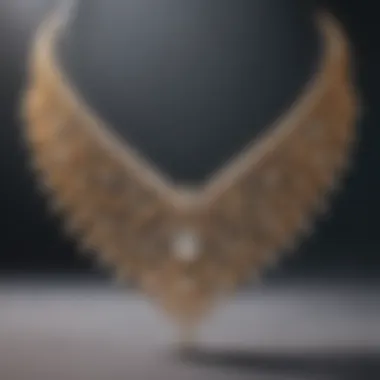Unraveling the Enigmatic World of Gold: A Detailed Look at 10k, 14k, 18k, and 24k Variants


Overview of Gold Types and Purity
Gold has captivated human imagination for centuries, revered for its intrinsic value and alluring beauty. In this comprehensive guide, we embark on a journey to unravel the mysteries of 10k, 14k, 18k, and 24k gold. Through an exploration of each type's composition, purity levels, and value, we seek to unveil the nuanced differences and complexities that define these variants.
Understanding the Composition and Properties of Gold
Before delving into the specific karats, it's essential to grasp the fundamental composition and properties of gold. Each karatage represents the gold content in the alloy — with 24k being pure gold. The lower karats, such as 10k, contain a higher percentage of other metals, making them more durable but less pure. Understanding these properties forms the basis for discerning the qualities of each gold type.
Unraveling Differences in Purity and Value
The purity and value of gold are intricately linked to its karatage. 24k gold, being pure, is softer and more prone to scratches compared to lower karatages that incorporate stronger metals. As we navigate through 10k, 14k, 18k, and 24k gold, we uncover how purity impacts not just the appearance but also the durability and desirability of these gold variants. By shedding light on these distinctions, we enable readers to make informed decisions when acquiring or investing in gold jewelry or bullion.
Introduction
Gold has always captivated humanity with its intrinsic beauty and timeless allure. In this expansive guide, we aim to unravel the mysteries surrounding different gold compositions, specifically delving into the intricacies of 10k, 14k, 18k, and 24k gold. Understanding the composition of these variants is paramount in appreciating their unique qualities and characteristics, making this topic a crucial starting point in our exploration. Gold, renowned for its luster and durability, holds a significant place in various industries, from jewelry making to investment. Analyzing the subtle differences between 10k, 14k, 18k, and 24k gold not only sheds light on their individual properties but also unveils the craftsmanship and expertise required in working with each type. Through this guide, readers will not only gain a deeper understanding of gold composition but also appreciate the artistry and precision involved in creating exquisite pieces from these distinct gold variants.
Exploring Gold Composition
Gold composition is an intricate subject that holds significant relevance in the realm of precious metals. In this comprehensive guide to understanding 10k, 14k, 18k, and 24k gold, exploring gold composition becomes a pivotal starting point. By unraveling the unique attributes of each gold type, readers gain insights into the materials' purity, durability, and aesthetic properties. Gold composition not only dictates the value of the metal but also plays a crucial role in determining its application in various industries, from jewelry making to technological advancements.


Defining 10k Gold
10k gold, also known as 10 karat gold, signifies that the metal is composed of 41.7% pure gold mixed with other metals like silver, copper, or zinc. The lower gold content in 10k gold makes it more durable and resistant to scratches compared to higher karat gold. While 10k gold may have a slightly paler hue due to the higher concentration of alloyed metals, it remains a popular choice for affordability and durability in jewelry making. Understanding the composition of 10k gold provides insights into its strength and suitability for everyday wear, offering a balance between aesthetics and practicality.
Insight into 14k Gold
14k gold embodies a composition of 58.3% pure gold blended with a mix of metals to enhance its durability and color. This intermediate karatage strikes a balance between richness of color and hardness, making it a favored choice for engagement rings and fine jewelry pieces. The alloyed metals in 14k gold contribute to its sturdiness, making it ideal for intricate designs while maintaining a luxurious feel. Exploring the composition of 14k gold unveils its versatile nature, suitable for a wide range of jewelry styles while ensuring longevity and value.
Understanding 18k Gold
At 75% pure gold, 18k gold exudes a luxurious and rich hue, making it a top choice for high-end jewelry and statement pieces. The intricate composition of 18k gold adds a touch of opulence while retaining durability and craftsmanship. The higher gold content in 18k gold results in a softer metal compared to lower karatages, making it more susceptible to scratches but easily polished to restore its luster. Understanding the properties of 18k gold provides discerning individuals with insights into its premium quality and timeless appeal, ideal for heirloom pieces and upscale jewelry creations.
Decoding 24k Gold
24k gold represents the pinnacle of purity, consisting of 99.9% pure gold without any alloyed metals. This pure form of gold boasts a vibrant and intense yellow color, setting it apart as the most valuable and coveted among all gold types. However, the inherent softness of 24k gold makes it less practical for everyday jewelry, often reserved for investment pieces or cultural ornaments. Delving into the composition of 24k gold elevates one's appreciation for its unmatched purity and rareness, symbolizing wealth and prestige in the world of luxury goods.
Analyzing Gold Purity
Gold purity is a crucial aspect of the precious metal that determines its value and quality. In this section of the article, we delve deep into the significance of understanding gold purity and its implications on the various types of gold - 10k, 14k, 18k, and 24k. Analyzing gold purity allows us to grasp the true essence of each gold variant, shedding light on the intricate details that make them unique. By exploring the composition of each type and how it influences purity, readers can gain a profound insight into the world of gold.


When focusing on the purity levels of 10k gold, we come across intriguing implications that shape its characteristics and market value. At 10k purity, gold is made up of 41.7% pure gold along with other metals. This lower purity level results in greater durability and affordability, making 10k gold a practical choice for everyday jewelry pieces. However, it is essential to consider the trade-offs in terms of color and value when opting for 10k gold jewelry.
Comparing the purity levels between 14k and 18k gold unveils contrasting features that cater to different preferences and purposes. While 14k gold consists of 58.3% pure gold, 18k gold boasts a higher purity at 75%. This variance in purity levels affects factors like color intensity, durability, and price. Understanding the distinctions between 14k and 18k gold helps individuals make informed decisions based on their desires for jewelry characteristics.
Exploring the realm of 24k gold purity reveals the purest form of gold available, consisting of 99.9% gold. This exceptional level of purity grants 24k gold a distinctive bright yellow hue and unparalleled softness. While 24k gold exudes luxury and exclusivity, it is also more prone to scratches and bending due to its malleable nature. By delving into 24k gold purity, readers can appreciate the rarity and uniqueness of this prized metal.
Evaluating Gold Value
Gold holds a distinct allure not only for its aesthetic appeal but also for its inherent value. In the realm of fine jewelry and investment, evaluating the worth of gold becomes a paramount consideration. This section aims to shed light on the multifaceted nature of gold value assessment, delving into the key elements that dictate the value of this precious metal. By understanding the various factors that influence gold's worth, readers can make informed decisions regarding purchasing, selling, or investing in gold.
Market Value of 10k Gold
When delving into the world of gold, one comes across various alloys varying in purity levels. 10k gold, comprising 41.7% pure gold mixed with other metals, occupies a unique position in the market due to its durability and affordability. Understanding the market dynamics governing the price of 10k gold is essential for both buyers and sellers. Factors such as fluctuations in gold prices, demand-supply dynamics, and economic indicators play a pivotal role in determining the market value of 10k gold. Delving into these aspects allows individuals to grasp the market trends affecting 10k gold prices and make informed decisions based on market insights.
Value Proposition: 14k vs. 18k Gold
The debate between 14k and 18k gold often perplexes buyers seeking the perfect balance between gold purity and durability. While 14k gold contains 58.3% pure gold, 18k gold boasts a higher purity of 75%. In this section, we unravel the value proposition offered by these two gold variants, examining aspects such as color, durability, and price differentials. By elucidating the nuanced differences between 14k and 18k gold, readers can navigate the complexities of selecting the ideal gold type to suit their preferences and requirements.
Investment Potential: 24k Gold


As the epitome of purity, 24k gold stands out as the most precious and sought-after gold variant in the market. With a purity level of 99.9%, 24k gold symbolizes ultimate luxury and investment potential. This section explores the unparalleled allure and investment benefits of 24k gold, shedding light on factors influencing its value retention and market demand. By delving into the exclusive realm of 24k gold investments, individuals can grasp the long-term advantages and considerations associated with owning this purest form of gold.
Utilizing Gold in Jewelry
10k Gold in Jewelry Making
Exploring the realm of 10k gold in jewelry making unveils a myriad of considerations and possibilities. 10k gold, consisting of 41.7% pure gold mixed with alloy metals, offers a balance between durability and affordability. Jewelry crafted from 10k gold is more resistant to wear and tear, making it suitable for daily wear pieces like bracelets and rings. Although 10k gold may have a lower gold content compared to higher karats, its strength and resilience make it a practical choice for pieces that require frequent use. Understanding the characteristics and limitations of 10k gold in jewelry making is essential for both designers and consumers seeking to create lasting and meaningful pieces.
14k and 18k Gold: Jewelry Design Considerations
Diving into the nuances of 14k and 18k gold for jewelry design opens a world of creative possibilities and challenges. The versatile nature of 14k and 18k gold allows craftsmen to innovate with different textures, styles, and settings. 14k gold, with a higher gold content than 10k gold, strikes a balance between durability and purity, making it a popular choice for a wide range of jewelry pieces. On the other hand, 18k gold, with 75% pure gold, exudes a lustrous warmth that lends itself beautifully to intricate and intricate designs. Design considerations such as color, hardness, and cost come into play when deciding between 14k and 18k gold for jewelry making. By exploring this section, readers will delve into the art of balancing aesthetics with practicality in jewelry design.
Luxury Appeal of 24k Gold Jewelry
The luxury appeal of 24k gold jewelry is unparalleled, boasting a purity level of 99.9% pure gold. 24k gold, often referred to as 'pure gold,' exudes a rich, yellow hue that signifies opulence and prestige. Jewelry crafted from 24k gold showcases the uncompromised beauty and shine of pure gold, making it a statement piece for those seeking the ultimate in luxury. However, the softness of 24k gold poses challenges in jewelry making, requiring careful handling and maintenance due to its susceptibility to scratches and dents. Understanding the exclusive allure and maintenance requirements of 24k gold jewelry is essential for connoisseurs looking to adorn themselves with the epitome of extravagance.
Conclusion
In dissecting the multifaceted realm of gold, the concluding section serves as the cornerstone that solidifies the enlightening journey embarked upon. Through an intricate tapestry of knowledge, this final segment encapsulates the essence of the entire guide while fortifying the reader's comprehension of the divergent aspects of gold purity and value.
Highlighting the critical facets discussed throughout the guide, the Conclusion section functions as a compass that navigates readers through the labyrinth of complexities surrounding 10k, 14k, 18k, and 24k gold. By consolidating the key insights presented in the previous sections, this concluding portion acts as a linchpin, uniting the fragmented pieces of information into a coherent whole.
Delving deeper into the specifics, the Conclusion provides a nuanced assessment of the pertinence of each gold variant in the context of jewelry making, investment choices, and aesthetic preferences. By offering a comprehensive synthesis of the differences in composition, purity levels, and market values, this section equips readers with the discernment needed to make informed decisions regarding the selection and usage of gold in various avenues.
Moreover, the Conclusion underscores the intrinsic connection between knowledge and empowerment in the realm of gold, elucidating how a profound understanding of the intricacies of 10k, 14k, 18k, and 24k gold can elevate one's appreciation for the value and allure of these precious metals. It beckons the reader to embrace a more informed perspective, empowering them to navigate the saturated market of gold jewelry with acumen and sophistication.
As the final chapter in the epilogue of this all-encompassing guide to gold, the Conclusion not only synthesizes the information presented but also beckons readers to embark on their own voyage of discovery, armed with newfound insights and a deeper appreciation for the mysteries that shroud these gleaming treasures.







